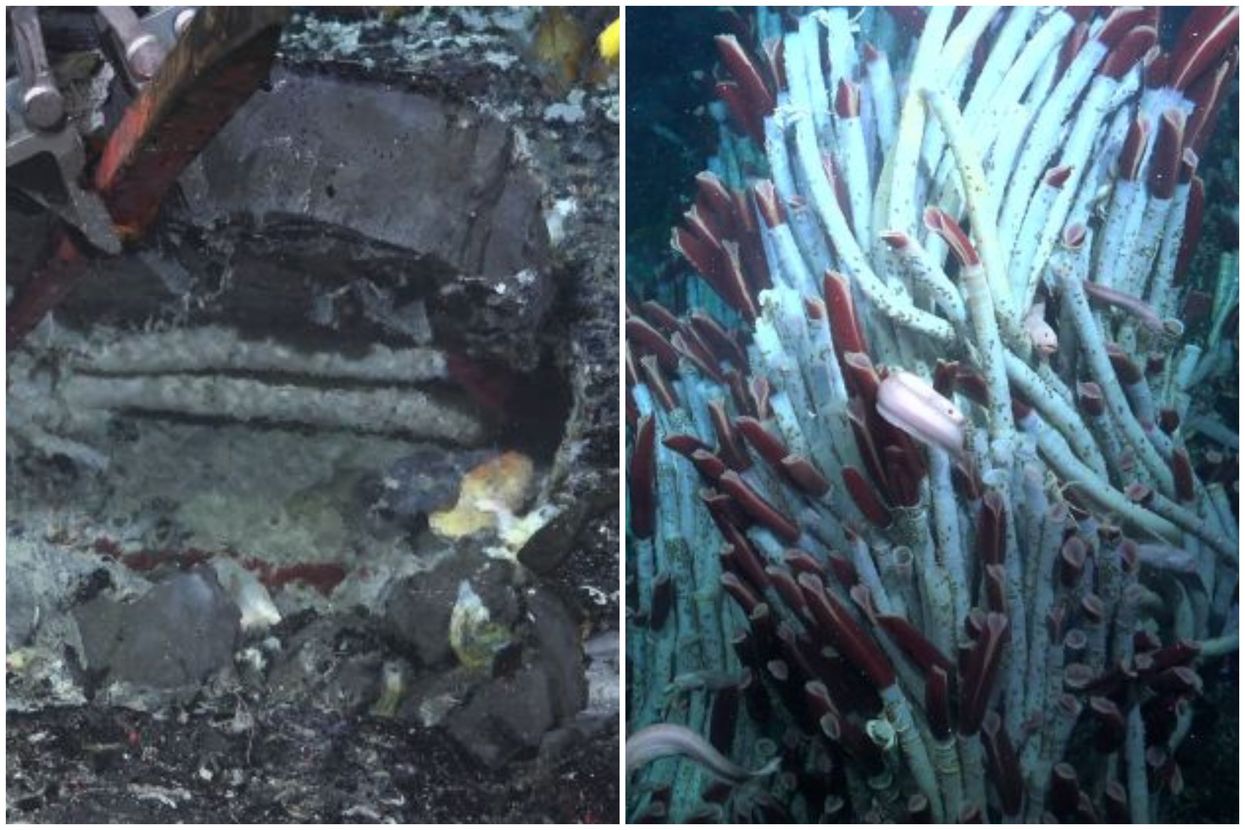Science & Tech
Harriet Brewis
Apr 18, 2025
Mysterious Holes On the Seafloor Just Off the Coast of California Might …
ZMG - Amaze Lab / VideoElephant
The ability of certain creatures to thrive in some of the most hostile environments on Earth is one of life’s great wonders.
And now, new research suggests that strange animals can survive in parts of the planet that we humans can’t even reach.
For the first time ever, scientists have discovered whole communities of complex lifeforms living underneath the seafloor.
And we’re not just talking about microbes here, but about giant, three-metre-long worms (that’s almost 10 feet), as well as snails, mussels and other recognisable beasts.
These creatures were found dwelling 2,515 metres (8,250 feet) below the surface of the Pacific Ocean in hidden holes within a hydrothermal vent field.
The prospect of these animals surviving the crushing pressure and intense cold at such depths is staggering, and shows just how resilient and adaptable certain lifeforms can be.
Indeed, these environments are so inhospitable that they are hard to study, meaning our understanding of their nature is limited.
However, thanks to advances in remote-controlled technology that enable experts to send equipment down to this icy abyss, we are uncovering more and more of their secrets.
[rebelmouse-image 53820827 expand=1 dam="0" alt="A glimpse at one of the subsurface cavities discovered in the East Pacific Rise hydrothermal vent field, surrounded by worms" site_id=24473854 is_animated_gif=false original_size="1200x675" crop_info="%7B%22image%22%3A%20%22https%3A//assets.rbl.ms/53820827/origin.webp%22%2C%20%22thumbnails%22%3A%20%7B%22origin%22%3A%20%22https%3A//assets.rbl.ms/53820827/origin.webp%22%2C%20%22300x%22%3A%20%22https%3A//www.indy100.com/media-library/eyJhbGciOiJIUzI1NiIsInR5cCI6IkpXVCJ9.eyJpbWFnZSI6Imh0dHBzOi8vYXNzZXRzLnJibC5tcy81MzgyMDgyNy9vcmlnaW4ud2VicCIsImV4cGlyZXNfYXQiOjE3NTc5NTI4MzN9.WkuQsJI2seyeBnXxts19EJ0HmF7DpG8JoznmOjQnyUE/image.webp%3Fwidth%3D300%22%2C%20%22600x300%22%3A%20%22https%3A//www.indy100.com/media-library/eyJhbGciOiJIUzI1NiIsInR5cCI6IkpXVCJ9.eyJpbWFnZSI6Imh0dHBzOi8vYXNzZXRzLnJibC5tcy81MzgyMDgyNy9vcmlnaW4ud2VicCIsImV4cGlyZXNfYXQiOjE3NTc5NTI4MzN9.WkuQsJI2seyeBnXxts19EJ0HmF7DpG8JoznmOjQnyUE/image.webp%3Fwidth%3D600%26height%3D300%26coordinates%3D0%252C37%252C0%252C38%22%2C%20%221200x400%22%3A%20%22https%3A//www.indy100.com/media-library/eyJhbGciOiJIUzI1NiIsInR5cCI6IkpXVCJ9.eyJpbWFnZSI6Imh0dHBzOi8vYXNzZXRzLnJibC5tcy81MzgyMDgyNy9vcmlnaW4ud2VicCIsImV4cGlyZXNfYXQiOjE3NTc5NTI4MzN9.WkuQsJI2seyeBnXxts19EJ0HmF7DpG8JoznmOjQnyUE/image.webp%3Fwidth%3D1200%26height%3D400%26coordinates%3D0%252C137%252C0%252C138%22%2C%20%22750x1000%22%3A%20%22https%3A//www.indy100.com/media-library/eyJhbGciOiJIUzI1NiIsInR5cCI6IkpXVCJ9.eyJpbWFnZSI6Imh0dHBzOi8vYXNzZXRzLnJibC5tcy81MzgyMDgyNy9vcmlnaW4ud2VicCIsImV4cGlyZXNfYXQiOjE3NTc5NTI4MzN9.WkuQsJI2seyeBnXxts19EJ0HmF7DpG8JoznmOjQnyUE/image.webp%3Fwidth%3D750%26height%3D1000%26coordinates%3D346%252C0%252C347%252C0%22%2C%20%221245x700%22%3A%20%22https%3A//www.indy100.com/media-library/eyJhbGciOiJIUzI1NiIsInR5cCI6IkpXVCJ9.eyJpbWFnZSI6Imh0dHBzOi8vYXNzZXRzLnJibC5tcy81MzgyMDgyNy9vcmlnaW4ud2VicCIsImV4cGlyZXNfYXQiOjE3NTc5NTI4MzN9.WkuQsJI2seyeBnXxts19EJ0HmF7DpG8JoznmOjQnyUE/image.webp%3Fwidth%3D1245%26height%3D700%26coordinates%3D0%252C0%252C0%252C0%22%2C%20%22600x400%22%3A%20%22https%3A//www.indy100.com/media-library/eyJhbGciOiJIUzI1NiIsInR5cCI6IkpXVCJ9.eyJpbWFnZSI6Imh0dHBzOi8vYXNzZXRzLnJibC5tcy81MzgyMDgyNy9vcmlnaW4ud2VicCIsImV4cGlyZXNfYXQiOjE3NTc5NTI4MzN9.WkuQsJI2seyeBnXxts19EJ0HmF7DpG8JoznmOjQnyUE/image.webp%3Fwidth%3D600%26height%3D400%26coordinates%3D143%252C0%252C44%252C0%22%2C%20%221000x750%22%3A%20%22https%3A//www.indy100.com/media-library/eyJhbGciOiJIUzI1NiIsInR5cCI6IkpXVCJ9.eyJpbWFnZSI6Imh0dHBzOi8vYXNzZXRzLnJibC5tcy81MzgyMDgyNy9vcmlnaW4ud2VicCIsImV4cGlyZXNfYXQiOjE3NTc5NTI4MzN9.WkuQsJI2seyeBnXxts19EJ0HmF7DpG8JoznmOjQnyUE/image.webp%3Fwidth%3D1000%26height%3D750%26coordinates%3D150%252C0%252C150%252C0%22%2C%20%22300x300%22%3A%20%22https%3A//www.indy100.com/media-library/eyJhbGciOiJIUzI1NiIsInR5cCI6IkpXVCJ9.eyJpbWFnZSI6Imh0dHBzOi8vYXNzZXRzLnJibC5tcy81MzgyMDgyNy9vcmlnaW4ud2VicCIsImV4cGlyZXNfYXQiOjE3NTc5NTI4MzN9.WkuQsJI2seyeBnXxts19EJ0HmF7DpG8JoznmOjQnyUE/image.webp%3Fwidth%3D300%26height%3D300%26coordinates%3D262%252C0%252C263%252C0%22%2C%20%22980x%22%3A%20%22https%3A//www.indy100.com/media-library/eyJhbGciOiJIUzI1NiIsInR5cCI6IkpXVCJ9.eyJpbWFnZSI6Imh0dHBzOi8vYXNzZXRzLnJibC5tcy81MzgyMDgyNy9vcmlnaW4ud2VicCIsImV4cGlyZXNfYXQiOjE3NTc5NTI4MzN9.WkuQsJI2seyeBnXxts19EJ0HmF7DpG8JoznmOjQnyUE/image.webp%3Fwidth%3D980%22%2C%20%22600x200%22%3A%20%22https%3A//www.indy100.com/media-library/eyJhbGciOiJIUzI1NiIsInR5cCI6IkpXVCJ9.eyJpbWFnZSI6Imh0dHBzOi8vYXNzZXRzLnJibC5tcy81MzgyMDgyNy9vcmlnaW4ud2VicCIsImV4cGlyZXNfYXQiOjE3NTc5NTI4MzN9.WkuQsJI2seyeBnXxts19EJ0HmF7DpG8JoznmOjQnyUE/image.webp%3Fwidth%3D600%26height%3D200%26coordinates%3D0%252C137%252C0%252C138%22%2C%20%222000x1500%22%3A%20%22https%3A//www.indy100.com/media-library/eyJhbGciOiJIUzI1NiIsInR5cCI6IkpXVCJ9.eyJpbWFnZSI6Imh0dHBzOi8vYXNzZXRzLnJibC5tcy81MzgyMDgyNy9vcmlnaW4ud2VicCIsImV4cGlyZXNfYXQiOjE3NTc5NTI4MzN9.WkuQsJI2seyeBnXxts19EJ0HmF7DpG8JoznmOjQnyUE/image.webp%3Fwidth%3D2000%26height%3D1500%26coordinates%3D150%252C0%252C150%252C0%22%2C%20%22600x600%22%3A%20%22https%3A//www.indy100.com/media-library/eyJhbGciOiJIUzI1NiIsInR5cCI6IkpXVCJ9.eyJpbWFnZSI6Imh0dHBzOi8vYXNzZXRzLnJibC5tcy81MzgyMDgyNy9vcmlnaW4ud2VicCIsImV4cGlyZXNfYXQiOjE3NTc5NTI4MzN9.WkuQsJI2seyeBnXxts19EJ0HmF7DpG8JoznmOjQnyUE/image.webp%3Fwidth%3D600%26height%3D600%26coordinates%3D262%252C0%252C263%252C0%22%2C%20%2235x35%22%3A%20%22https%3A//www.indy100.com/media-library/eyJhbGciOiJIUzI1NiIsInR5cCI6IkpXVCJ9.eyJpbWFnZSI6Imh0dHBzOi8vYXNzZXRzLnJibC5tcy81MzgyMDgyNy9vcmlnaW4ud2VicCIsImV4cGlyZXNfYXQiOjE3NTc5NTI4MzN9.WkuQsJI2seyeBnXxts19EJ0HmF7DpG8JoznmOjQnyUE/image.webp%3Fwidth%3D35%26height%3D35%22%2C%20%22400x225%22%3A%20%22https%3A//www.indy100.com/media-library/eyJhbGciOiJIUzI1NiIsInR5cCI6IkpXVCJ9.eyJpbWFnZSI6Imh0dHBzOi8vYXNzZXRzLnJibC5tcy81MzgyMDgyNy9vcmlnaW4ud2VicCIsImV4cGlyZXNfYXQiOjE3NTc5NTI4MzN9.WkuQsJI2seyeBnXxts19EJ0HmF7DpG8JoznmOjQnyUE/image.webp%3Fwidth%3D400%26height%3D225%26coordinates%3D0%252C0%252C0%252C0%22%2C%20%22210x%22%3A%20%22https%3A//www.indy100.com/media-library/eyJhbGciOiJIUzI1NiIsInR5cCI6IkpXVCJ9.eyJpbWFnZSI6Imh0dHBzOi8vYXNzZXRzLnJibC5tcy81MzgyMDgyNy9vcmlnaW4ud2VicCIsImV4cGlyZXNfYXQiOjE3NTc5NTI4MzN9.WkuQsJI2seyeBnXxts19EJ0HmF7DpG8JoznmOjQnyUE/image.webp%3Fwidth%3D210%22%2C%20%221200x800%22%3A%20%22https%3A//www.indy100.com/media-library/eyJhbGciOiJIUzI1NiIsInR5cCI6IkpXVCJ9.eyJpbWFnZSI6Imh0dHBzOi8vYXNzZXRzLnJibC5tcy81MzgyMDgyNy9vcmlnaW4ud2VicCIsImV4cGlyZXNfYXQiOjE3NTc5NTI4MzN9.WkuQsJI2seyeBnXxts19EJ0HmF7DpG8JoznmOjQnyUE/image.webp%3Fwidth%3D1200%26height%3D800%26coordinates%3D143%252C0%252C44%252C0%22%2C%20%22700x1245%22%3A%20%22https%3A//www.indy100.com/media-library/eyJhbGciOiJIUzI1NiIsInR5cCI6IkpXVCJ9.eyJpbWFnZSI6Imh0dHBzOi8vYXNzZXRzLnJibC5tcy81MzgyMDgyNy9vcmlnaW4ud2VicCIsImV4cGlyZXNfYXQiOjE3NTc5NTI4MzN9.WkuQsJI2seyeBnXxts19EJ0HmF7DpG8JoznmOjQnyUE/image.webp%3Fwidth%3D700%26height%3D1245%26coordinates%3D410%252C0%252C410%252C0%22%2C%20%221200x600%22%3A%20%22https%3A//www.indy100.com/media-library/eyJhbGciOiJIUzI1NiIsInR5cCI6IkpXVCJ9.eyJpbWFnZSI6Imh0dHBzOi8vYXNzZXRzLnJibC5tcy81MzgyMDgyNy9vcmlnaW4ud2VicCIsImV4cGlyZXNfYXQiOjE3NTc5NTI4MzN9.WkuQsJI2seyeBnXxts19EJ0HmF7DpG8JoznmOjQnyUE/image.webp%3Fwidth%3D1200%26height%3D600%26coordinates%3D0%252C37%252C0%252C38%22%2C%20%22600x%22%3A%20%22https%3A//www.indy100.com/media-library/eyJhbGciOiJIUzI1NiIsInR5cCI6IkpXVCJ9.eyJpbWFnZSI6Imh0dHBzOi8vYXNzZXRzLnJibC5tcy81MzgyMDgyNy9vcmlnaW4ud2VicCIsImV4cGlyZXNfYXQiOjE3NTc5NTI4MzN9.WkuQsJI2seyeBnXxts19EJ0HmF7DpG8JoznmOjQnyUE/image.webp%3Fwidth%3D600%22%2C%20%221500x2000%22%3A%20%22https%3A//www.indy100.com/media-library/eyJhbGciOiJIUzI1NiIsInR5cCI6IkpXVCJ9.eyJpbWFnZSI6Imh0dHBzOi8vYXNzZXRzLnJibC5tcy81MzgyMDgyNy9vcmlnaW4ud2VicCIsImV4cGlyZXNfYXQiOjE3NTc5NTI4MzN9.WkuQsJI2seyeBnXxts19EJ0HmF7DpG8JoznmOjQnyUE/image.webp%3Fwidth%3D1500%26height%3D2000%26coordinates%3D346%252C0%252C347%252C0%22%2C%20%221200x675%22%3A%20%22https%3A//www.indy100.com/media-library/eyJhbGciOiJIUzI1NiIsInR5cCI6IkpXVCJ9.eyJpbWFnZSI6Imh0dHBzOi8vYXNzZXRzLnJibC5tcy81MzgyMDgyNy9vcmlnaW4ud2VicCIsImV4cGlyZXNfYXQiOjE3NTc5NTI4MzN9.WkuQsJI2seyeBnXxts19EJ0HmF7DpG8JoznmOjQnyUE/image.webp%3Fwidth%3D1200%26height%3D675%26coordinates%3D0%252C0%252C0%252C0%22%7D%2C%20%22manual_image_crops%22%3A%20%7B%22custom%22%3A%20%7B%22sizes%22%3A%20%5B%221200x675%22%5D%2C%20%22top%22%3A%200%2C%20%22height%22%3A%20675%2C%20%22width%22%3A%201200%2C%20%22left%22%3A%200%7D%2C%20%222x1%22%3A%20%7B%22sizes%22%3A%20%5B%221200x600%22%2C%20%22600x300%22%5D%2C%20%22top%22%3A%2037%2C%20%22height%22%3A%20600%2C%20%22width%22%3A%201200%2C%20%22left%22%3A%200%7D%2C%20%223x1%22%3A%20%7B%22sizes%22%3A%20%5B%221200x400%22%2C%20%22600x200%22%5D%2C%20%22top%22%3A%20137%2C%20%22height%22%3A%20400%2C%20%22width%22%3A%201200%2C%20%22left%22%3A%200%7D%2C%20%223x2%22%3A%20%7B%22sizes%22%3A%20%5B%221200x800%22%2C%20%22600x400%22%5D%2C%20%22top%22%3A%200%2C%20%22height%22%3A%20675%2C%20%22width%22%3A%201013%2C%20%22left%22%3A%20143%7D%2C%20%224x3%22%3A%20%7B%22sizes%22%3A%20%5B%222000x1500%22%2C%20%221000x750%22%5D%2C%20%22top%22%3A%200%2C%20%22height%22%3A%20675%2C%20%22width%22%3A%20900%2C%20%22left%22%3A%20150%7D%2C%20%223x4%22%3A%20%7B%22sizes%22%3A%20%5B%221500x2000%22%2C%20%22750x1000%22%5D%2C%20%22top%22%3A%200%2C%20%22height%22%3A%20675%2C%20%22width%22%3A%20507%2C%20%22left%22%3A%20346%7D%2C%20%221x1%22%3A%20%7B%22sizes%22%3A%20%5B%22600x600%22%2C%20%22300x300%22%5D%2C%20%22top%22%3A%200%2C%20%22height%22%3A%20675%2C%20%22width%22%3A%20675%2C%20%22left%22%3A%20262%7D%2C%20%229x16%22%3A%20%7B%22sizes%22%3A%20%5B%22700x1245%22%5D%2C%20%22top%22%3A%200%2C%20%22height%22%3A%20675%2C%20%22width%22%3A%20380%2C%20%22left%22%3A%20410%7D%2C%20%2216x9%22%3A%20%7B%22sizes%22%3A%20%5B%221245x700%22%2C%20%22400x225%22%5D%2C%20%22top%22%3A%200%2C%20%22height%22%3A%20675%2C%20%22width%22%3A%201200%2C%20%22left%22%3A%200%7D%7D%7D" image_crop="3x2" pin_description="" caption="A glimpse at one of the subsurface cavities which was "broken into" thanks to remotely operated vehicles" photo_credit="(Schmidt Ocean Institute)"] A glimpse at one of the subsurface cavities which was "broken into" thanks to remotely operated vehicles(Schmidt Ocean Institute)
The groundbreaking new discoveries were made in fluid-filled cavities nestled between two converging crusts in the East Pacific Rise hydrothermal vent field.
The team of researchers, led by the University of Vienna and the Royal Netherlands Institute for Sea Research, found giant tubeworms (also known as beardworms) living happily in these secret pockets.
Marine biologist Monika Bright, of the University of Vienna, voiced her amazement at the find, telling Science Alert that they didn’t even know the cavities were there.
Then, once they “broke into” these crevices, they were stunned to see an entire, flourishing ecosystem, consisting of at least 10 different species.
The cavities exist around 10 centimetres (four inches) below the seafloor, and are filled with water warmed by volcanic activity to temperatures of about 25C (77C).
- YouTubeyoutu.be
The question Bright and her colleagues are now attempting to answer is: how did these creatures get down there?
And they believe that the larvae of these worms and other animals may be travelling beneath the ocean floor via vent fluids, and settling in this subsurface realm if the conditions are right.
This implies that there could be an abundance of life living within the Earth’s crust beneath the seabed in areas across the globe.
In other words, this is just the tip of the iceberg when it comes to uncovering what lives beneath our own surface world.
“The discovery of animal life beneath the surface of the Earth’s crust raises questions concerning the extent of these ecosystems, which is larger than what can be seen on the seafloor surface,” Bright and her colleagues wrote in a paper on their findings, published in the journal Nature Communications.
“The study of the subseafloor biosphere for animal life has just begun.”
This article was originally published on 16 October 2024
Sign up for our free Indy100 weekly newsletter
How to join the indy100's free WhatsApp channel
Have your say in our news democracy. Click the upvote icon at the top of the page to help raise this article through the indy100 rankings
Top 100
The Conversation (0)














